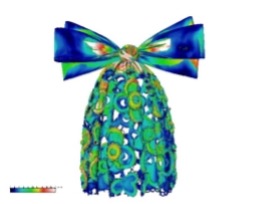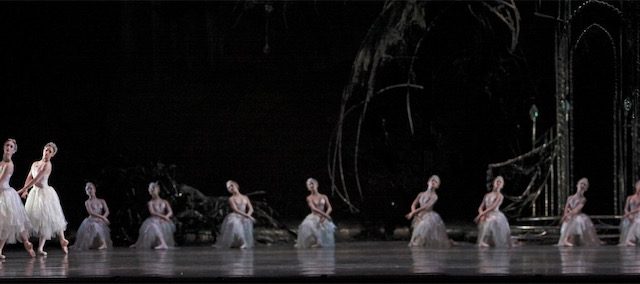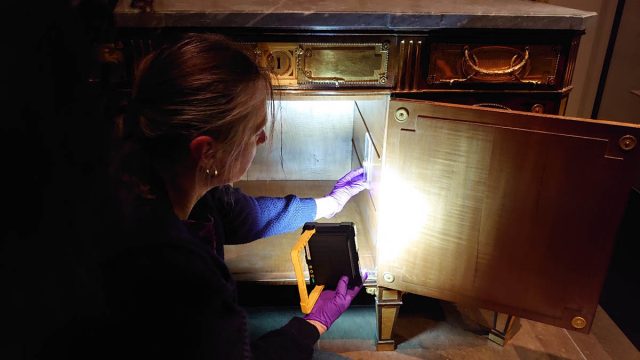It’s always a privilege to handle an object in the collection. In the Furniture and Woodwork collection one of the most exciting is undoubtedly Grinling Gibbons’ limewood Cravat of about 1690 – a single piece of limewood carved into the shape of a gentleman’s cravat with lace ends, worn around the neck and adorned with a bow.

Weighing just under 150g, no more than an apple, its delicacy makes it nerve-racking to handle. Special requests to study it closely have to be assessed against the risks of handling, and the disadvantages of taking it off public display.
Holding the cravat, you appreciate Gibbons’ achievements in new ways: what Horace Walpole called the ‘airy lightness’ of his work, the confidence with which he expresses fine detail in a visually convincing way, and the way he effects a metamorphosis of material – from solid wood into what appear to be soft textile. At the same time, you’re more aware of its materiality, the fibres of wood, the slicing cuts of his chisels, and the small damages it has previously suffered, particularly where tiny loops have been broken.
How can we share more widely the extraordinary experience of holding the cravat? In this anniversary year of England’s most famous wood carver (Gibbons died in August 1721), we have explored new ways of imaging and imagining his carving: 3D scanning and micro-CT scanning.
3D Scanning
A 3D scan allows an accurate three-dimensional representation of the carving to be manipulated on a 2D screen, available online so that anyone can digitally ‘handle’ it, and examine every detail and crevice. The small size of the cravat makes it a good candidate for scanning, but the great delicacy of surface carving and its open areas pose a tough challenge. Fred Hair of Form Capture used a structured light scanner linked to a powerful laptop, which was portable and feasible to set up at the V&A under Covid-19 restrictions. The scanner was passed repeatedly over the front, back and sides of the cravat, until all the areas had been recorded in sufficient detail. This took little more than an hour.
Much longer is the processing of the data into a clean 3D scan.
The 3D scan gives us the opportunity of creating a precise, tangible 3D print of the cravat. The degree of precision depends on the accuracy of the scan, the print quality and material. For the V&A, Form Capture used selective laser sintering (SLS) with PA2200 Polyamide 12 (Nylon 12) a strong nylon plastic, in brilliant white. We didn’t want a facsimile of the cravat that could be confused with the original, but something that replicated its form precisely and could be easily handled.

In fact, the 3D print has already proved useful, serving as a reference for the carver Clunie Fretton who has been filmed in her London workshop replicating the cravat for us. For accuracy, she needs to be able to refer continually to Gibbons’ work, but it would be impossible for her to keep the original close at hand while working on her carving. The re-carving project can be seen in this film.
X-ray micro-CT Scanning
An X-ray micro-CT (μCT) scan (properly known as X-ray micro computed tomography), also creates a 3D image – but, unlike a regular 3D scan, can reveal the internal structure of an object by exploiting differences in its X-ray absorption. This can provide information about composition, density, damage and modifications without destructive sampling. It’s like a medical CT, but with much higher spatial resolution: effectively a stack of 2-dimensional X-rays. In February 2021, for its 330 year check-up, the cravat travelled across Exhibition Road to the Natural History Museum, into the care of Dr Vincent Fernandez.
The cravat was fitted by a V&A conservator, with extreme care, into a specially made foam-board case for the short journey and so that it could rest vertically while inside the scanner. In fact, Vincent did not see the cravat with his own eyes: there was no need to unpack it because the scanner reveals everything.

While being slowly rotated over the course of an hour, the cravat was X-rayed from various angles.
As a relatively small, less dense object, this work did not take more than a couple of hours. More time consuming was the task of processing the thousands of images, to recompose the many ‘slices’ or digital cross sections into a virtual volume, a 3D digital density map. The scan would show any concealed joints or repairs to the carving, or even the depth of a tiny pinhole from which the cravat was once hung on the wall. The data can also be repackaged into a spectacular thickness map demonstrating where Gibbons cut the limewood down to as little as 1mm.

The technique of X-ray micro-CT really comes into its own when allowing us to slice an object open into virtual layers. A video version of the scan can be seen here.
Discover more on our website about what these high- tech explorations reveal about the cravat 300 years after Gibbons’ death.
We are extremely grateful to the NHM and Vincent Fernandez for his work on the scan.


